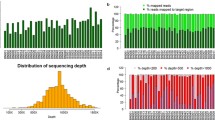Abstract
Frequent mutations in the GNAQ, MMP8, Akt3, EGFR, and PIK3R1 genes have been reported in human cancers but mostly have not been well examined in thyroid cancer. Selected exons of GNAQ, MMP8, AKT3, EGFR, and PIK3R1 genes were sequenced in various thyroid cancers. We found a G2203A EGFR mutation, resulting in a G735S amino acid change, in one of 21 (5%) papillary thyroid cancer samples. We did not find any mutation in the MMP8 gene, but observed a frequent SNP A259G (K87E) genotype switch in various types of thyroid cancer samples. We did not find any mutation in the GNAQ, AKT3, and PIK3R1genes in various types of thyroid cancer. No mutation in these genes was found in 12 cell lines derived from various types of thyroid cancer. Therefore, unlike in other cancers, mutations in these genes are uncommon in thyroid cancer.

Similar content being viewed by others
References
Leenhardt L, Grosclaude P & Cherie-Challine L. Increased incidence of thyroid carcinoma in France: a true epdemic or thyroid nodule management effects? Report from the French Thyroid Cancer Committee. Thyroid 14:1056–1060, 2004.
Sprague BL, Warren Andersen S & Trentham-Dietz A. Thyroid cancer incidence and socioeconomic indicators of health care access. Cancer Causes and Control 19:585–593, 2008.
Hundahl, I.D. Fleming, A.M. Fremgen and H.R. Menck, A national cancer data base report on 53,856 cases of thyroid carcinoma treated in the US, 1985–1995. Cancer 83:2638–2648, 1998.
Liu Z, Hou P, Ji M, Guan H, Studeman K, Jensen K, et al. Highly prevalent genetic alterations in receptor tyrosine kinases and phosphatidylinositol 3-kinase/akt and mitogen-activated protein kinase pathways in anaplastic and follicular thyroid cancers. J Clin Endocrinol Metab 93:3106–3116, 2008.
Van Raamsdonk CD, Bezrookove V, Green G, Bauer J, Gaugler L, O’Brien JM, et al. Frequent somatic mutations of GNAQ in uveal melanoma and bluenaevi. Nature 457:599–602, 2009.
Palavalli LH, Prickett TD, Wunderlich JR, Wei X, Burrell AS, Porter-Gill P, et al. Analysis of the matrix metalloproteinase family reveals that MMP8 is often mutated in melanoma. Nat Genet 41:518–520, 2009.
Davies MA, Stemke-Hale K, Tellez C, Calderone TL, Deng W, Prieto VG, et al. A novel AKT3 mutation in melanoma tumors and cell lines. Br J Cancer 99:1265–1268, 2008.
Dutt A, Salvesen HB, Greulich H, Sellers WR, Beroukhim R & Meyerson M. Somatic mutations are present in all members of the AKT family in endometrial carcinoma. Br J Cancer 101:1218–1219, 2009.
Masago K, Asato R, Fujita S, Hirano S, Tamura Y, Kanda T, et al., Epidermal growth factor receptor mutations in papillary thyroid carcinoma. Int J Cancer 124:2744–2749, 2009.
Jaiswal BS, Janakiraman V, Kljavin NM, Chaudhuri S, Stern HM, Wang W, et al. Somatic mutations in p85α promote tumorigenesis through class 1A PI3K activation. Cancer Cell 16:463–474, 2009.
Matsuse M, Mitsutake N, Nishihara E, Rogounovitch T, Saenko V, Rumyantsev P, et al. Lack of GNAQ hotspot mutation in papillary thyroid carcinomas. Thyroid 19: 921–922, 2009.
Lamba S, Felicioni L, Buttitta F, Bleeker FE, Malatesta S, Corbo V, et al. Mutational profile of GNAQQ209 in human tumors. PLoS One 4:e6833, 2009.
Cassol CA, Guo M, Ezzat S, Asa SL. GNAq mutations are not identified in papillary thyroid carcinomas and hyperfunctioning thyroid nodules. Endocr Pathol 21:250–252, 2010.
Sozopoulos E, Litsiou H, Voutsinas G, Mitsiades N, Anagnostakis N, Tseva T, et al. Mutational and immunohistochemical study of the PI3K/Akt pathway in papillary thyroid carcinoma in Greece. Endocr Pathol 21:90–100, 2010.
Mitsiades CS, Kotoula V, Poulaki V, Sozopoulos E, Negri J, Charalambous E, et al. Epidermal growth factor receptor as a therapeutic target in human thyroid carcinoma: mutational and functional analysis. J Clin Endocrinol Metab 91:3662–3666, 2006.
Murugan AK, Dong J, Xie J & Xing M. MEK1 mutations, but not ERK2 mutations, occur in melanomas and colon carcinomas, but none in thyroid carcinomas. Cell Cycle 8:2122–2124, 2009.
Nagai Y, Miyazawa H, Huqun, Tanaka T, Udagawa K, Kato M, et al. Genetic heterogeneity of the epidermal growth factor receptor in non-small cell lung cancer cell lines revealed by a rapid and sensitive detection system, the peptide nucleic acid-locked nucleic acid PCR clamp. Cancer Res 65:7276–7282, 2005.
Tsao MA, Sakurada A, Cutz JC, Zhu CQ, Kamel-Reid S, Squire J, et al. Erlotinib in lung cancer—molecular and clinical predictors of outcome. N Engl J Med 353:133–144, 2005.
Douglas DA, Zhong H, Ro JY, Oddoux C, Berger AD, Pincus MR, et al. Novel mutations of epidermal growth factor receptor in localized prostate cancer. Front Biosci 11:2518–2525, 2006.
Cai CQ, Peng Y, Buckley MT, Wei J, Chen F, Liebes L, et al. Epidermal growth factor receptor activation in prostate cancer by three novel missense mutations. Oncogene 27:3201–3210, 2008.
Ringel MD, Hayre N, Saito J, Saunier B, Schuppert F, Burch H, et al. Overexpression and overactivation of Akt in thyroid carcinoma. Cancer Res 6:6105–6111, 2001.
Ricarte-Filho JC, Ryder M, Chitale DA, Rivera M, Heguy A, Ladanyi M, et al. Mutational profile of advanced primary and metastatic radioactive iodine-refractory thyroid cancers reveals distinct pathogenetic roles for BRAF, PIK3CA, and AKT1. Cancer Res 69:4885–4893, 2009.
Acknowledgments
We thank Drs. NE Heldin, KB Ain, N Onoda, M Santoro, D Wynford Thomas, G Brabant, R Schweppe, and B Haugen for kindly providing us the accessibility to the cell lines used in this study.
Declaration of Interest
The authors have no conflict of interest to declare.
Funding
This study was supported by the NIH grant R01CA134225 to M. Xing.
Author information
Authors and Affiliations
Corresponding author
Rights and permissions
About this article
Cite this article
Murugan, A.K., Dong, J., Xie, J. et al. Uncommon GNAQ, MMP8, AKT3, EGFR, and PIK3R1 Mutations in Thyroid Cancers. Endocr Pathol 22, 97–102 (2011). https://doi.org/10.1007/s12022-011-9155-x
Published:
Issue Date:
DOI: https://doi.org/10.1007/s12022-011-9155-x




